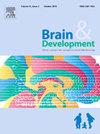Characteristics of febrile seizure after the end of the COVID-19 global health emergency
IF 1.3
4区 医学
Q4 CLINICAL NEUROLOGY
引用次数: 0
Abstract
Objective
This study aimed to clarify the characteristics of febrile seizures (FSs) before and after the coronavirus disease 2019 (COVID-19) global health emergency.
Methods
This study was a retrospective study conducted at a single institution in Japan. Clinical data were retrospectively collected from 797 children with FS, aged <16 years, between January 2018 and July 2024. Participants were categorized into four terms: Term I, pre-COVID-19 period; Term II, pre-Omicron period; Term III, Omicron period; and Term IV, post-COVID-19 global health emergency. Late FS was defined as FS in children aged >60 months. Data were compared across these four periods and between COVID-19-related and non-COVID-19-related groups.
Results
The monthly average of FSs was 14.4 in Term I, 7.7 in Term II, 11.6 in Term III, and 12.5 in Term IV. The median age in Term IV was 34 months, significantly older than in Terms I, II, and III. Late FS in the COVID-19-related group was 22.6 % in Term III and 25 % in Term IV. In the non-COVID-19-related group, late FS rates were 5.0 % in Term I, 2.7 % in Term II, 4.7 % in Term III, and 26.0 % in Term IV, significantly higher than in Terms I, II, and III.
Conclusions
After the end of the COVID-19 global health emergency, the rate of late FS caused by COVID-19 remained high, and the rate of late FS caused by non-COVID-19 infections also increased compared to the pre-COVID-19 period.
COVID-19全球突发卫生事件结束后的热性惊厥特征
目的探讨2019冠状病毒病(COVID-19)全球突发卫生事件发生前后的发热性惊厥(FSs)特征。方法本研究为回顾性研究,在日本一家机构进行。回顾性收集2018年1月至2024年7月期间797名16岁FS患儿的临床资料。参与者被分为四个阶段:第一阶段,covid -19前期;第二学期,前欧米克隆期;第三学期,欧米克隆周期;第四阶段,covid -19后全球突发卫生事件。晚期FS定义为60月龄儿童FS。对这四个时期以及与covid -19相关和非covid -19相关组之间的数据进行了比较。结果第一、二、三期患者FSs月均14.4个月、7.7个月、11.6个月、12.5个月,年龄中位数为34个月,明显大于第一、二、三期患者。在与covid -19相关的组中,晚期FS在III期为22.6%,在IV期为25%。在非covid -19相关组中,晚期FS在I期为5.0%,II期为2.7%,III期为4.7%,IV期为26.0%,显著高于I、II和III期。结论COVID-19全球突发卫生事件结束后,由COVID-19引起的晚期FS发生率仍然很高,非COVID-19感染引起的晚期FS发生率也较COVID-19前有所上升。
本文章由计算机程序翻译,如有差异,请以英文原文为准。
求助全文
约1分钟内获得全文
求助全文
来源期刊

Brain & Development
医学-临床神经学
CiteScore
3.60
自引率
0.00%
发文量
153
审稿时长
50 days
期刊介绍:
Brain and Development (ISSN 0387-7604) is the Official Journal of the Japanese Society of Child Neurology, and is aimed to promote clinical child neurology and developmental neuroscience.
The journal is devoted to publishing Review Articles, Full Length Original Papers, Case Reports and Letters to the Editor in the field of Child Neurology and related sciences. Proceedings of meetings, and professional announcements will be published at the Editor''s discretion. Letters concerning articles published in Brain and Development and other relevant issues are also welcome.
 求助内容:
求助内容: 应助结果提醒方式:
应助结果提醒方式:


